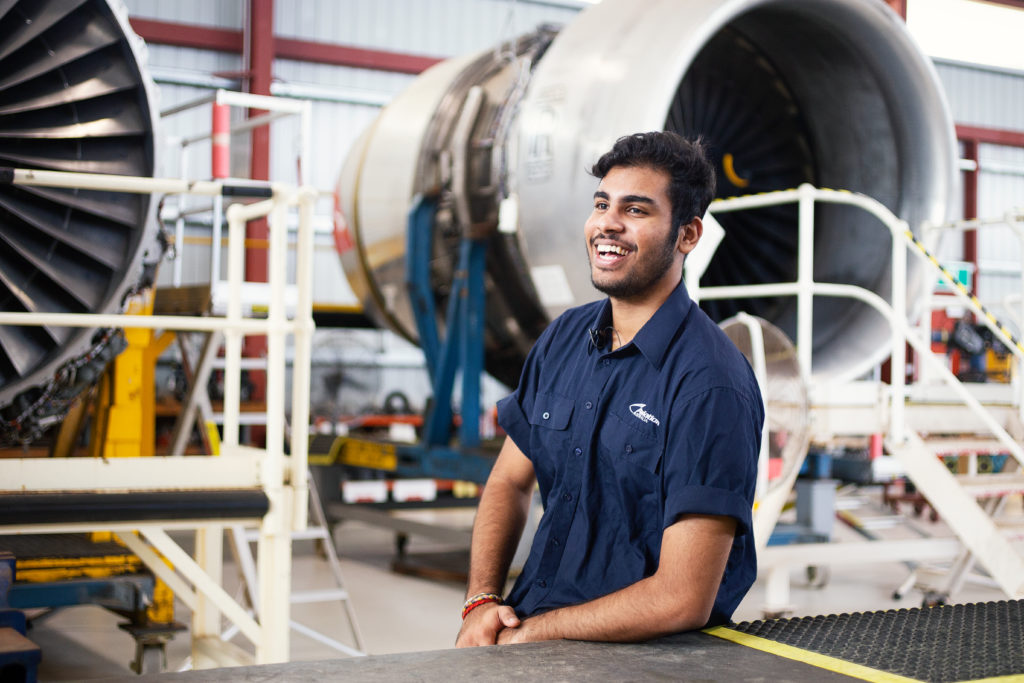What is aviation engineering, and why is it a career of the future?
Globalisation, automation and rapidly changing needs mean the future of employment will probably look very different to now. In fact, many current careers won’t exist in the next 10 to 20 years. So, it’s critical that students ask the important question: ‘Will my chosen study path lead to strong job opportunities after graduation and beyond?’
In this series, we’re exploring a range of occupations forecast to have strong employment prospects in the future.
We spoke to Charlie Mifsud, technical instructor at Aviation Australia, about his experience in the aviation industry, his work teaching new engineers, and how it all works at Aviation Australia!
A lifetime in the industry
Charlie began his career in aviation in 1974 in the Royal Australian Airforce. There, he worked as an aircraft sheet metal worker for six years, before moving to general aviation.
He studied to become a Licensed Aircraft Maintenance Engineer (LAME) and has continued in this line of work since 1988. He’s worked on hundreds of different aircraft, from a Cessna 150 to a Boeing 747, and most helicopters around Australia.
Over the last ten years, he has moved from Melbourne to Brisbane to become a technical instructor with Aviation Australia.
“My role with Aviation Australia is basically instilling the skills to our students. I help our international Diploma students for 20 weeks, teaching them policies and processes, and how to use the tools to work on aircraft,” he says.
Charlie has always had a passion for aviation, and it’s this passion that ensures that his work is always completed to the highest standard possible.
“I see aeroplanes as living, breathing entities, and I’m the guy that’s in charge of keeping them that way,” he says. “There’s no better feeling than being in heavy maintenance with a dead aircraft that’s been in the hangar for three months and then seeing it fly for the first time. That’s what excites me about this industry.”
What is aviation engineering?
Aviation engineering (or aircraft/aeronautical engineering) is essentially motor mechanics for aircraft. You’ve likely experienced a flight delay at some point in your life. Did you know that the person who gets things back on track and releases the aircraft to fly is not the pilot, but the LAME?
The Part 66 Manual of Standards (MOS) outlines the training requirements to qualify for a licence to become an aviation engineer, and there are two training pathways you can choose from. Let’s take you through the Part 147 Maintenance Training Organisation (MTO) pathway.
This pathway involves:
- formalised licence category training and examination, and
- assessment of practical experience.
If you choose to undertake your licence category training via this pathway, you will enrol as a student at one of the CASA-approved Part 147 MTOs – for example, Aviation Australia – and study under the Australian Vocational Education and Training (VET) system to gain one of the relevant qualifications outlined below:
- For a Category B1 or B2 licence — Diploma level
- For a Category A licence — Certificate II level
For a Category B1 or B2 license, there are two pathways. B1 focuses on the mechanics of engines and airframes. B2 explores avionics, which are electric and radio systems. Some licensed engineers may choose to split their focus across both areas, rather than just focusing on either mechanical or electrical.
“Once they complete their chosen pathway, students can apply to the Civil Aviation Safety Authority (CASA) to become licensed aircraft engineers. This gives them the authority to certify their work on an aircraft and give a certificate of release, meaning that they are signing the aircraft off to say that it is airworthy and you can fly it,” Charlie says.
“It’s a black and white industry, there is no grey. As long as you do the right things, you don’t have any problems. Our main role is to keep aircraft up in the air and the people safe.”
Where can you work with your aviation engineering qualifications?
As a LAME, you can expect to work in general aviation, or with domestic and international airlines, aerospace companies or defence forces.
At Aviation Australia, a module of each of the different Diplomas of Aircraft Maintenance Engineering focuses on industry regulations and can be related back to your home country. This can allow you to get a job in Australia, your home country, or anywhere else in the world you’d like to work.
“There are variations in regulations from country to country, so that’s why it’s important that we cover [international students’] country of origin as well,” says Charlie.
The future of aviation
A lot has changed in the world of aviation over the last several decades.
“Basically, with the aircraft, they’re getting so smart that they actually have computers on board that you can interrogate. The aircraft can actually tell you what’s wrong with it,” says Charlie.
The computers are so impressive that if the aircraft recognises a fault in its systems, it can immediately alert the crew and send a message to the destination crew so that once the aircraft touches down, the on-ground engineers are able to get to work fixing the issue as quickly as possible.
“The engineering of aircraft is ever evolving. They’re getting smarter and smarter with their technologies. I’ve been in the industry for 48 years now, and I’ve seen so many changes. It’s a constant learning evolution and once you start in aviation you never stop learning. I’m still learning,” says Charlie.
Aircraft mechanics in everyday life
Something that may interest you to know about a career in aviation is how transferable the skills you learn can be to other aspects of your life. For example, once you know how a plane works it’s fairly easy to understand how a car works.
“A lot of the guys here who have worked their whole lives in engineering, they restore motorbikes or cars, or they do woodwork, basic plumbing – it’s very transferable for home improvement things,” says Charlie.
So, what are you waiting for? Your career in aviation engineering awaits!






